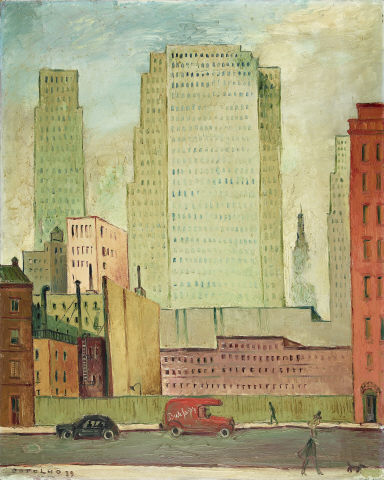
- Carton
- Oil
- Inv. 80P92
Carlos Botelho
Nova York, Rua 53
In 1939, the International Exhibition took place in New York. Carlos Botelho, the painter and decorator of the pavilions that represented Portugal at countless international fairs, was also present. Besides the work that took him there, he was also visiting the city, attending the commemoration of the 10th anniversary of the MoMA. However, everything seems to indicate that what most fascinated Botelho was the city grid itself. In effect, between 1930 and 1941, the artist’s favourite theme was the urban landscape. It was during those years – which coincided with the period in which the painter travelled the most, and which gave rise to the eloquent results that appeared in the supplement «Ecos da Semana» – that he also devoted himself to inventing the multiple facets of Lisbon. In 1939, when New York first appeared on the painter’s itinerary, the city seemed to rise up like the urban and pictorial counterpoint to the Lisbon he was recreating. Botelho left the horizontal lines of the European city for the verticality of the North American urban landscape. And, rather than depictingviews from the tops of hills, which offered a more distant perspective, the painter, in the flat city, created this picture as a close up, which resulted in a fuller composition, one imbued with a particular dynamism. It is true that, in some drawings of New York, we find views captured from a distance. What we are offered in this work, however, is something quite different.
Depicting New York as a city of contrasts, which he knew from travelling around and paying close attention to detail (see the page in «Ecos da Semana» dating from 11 May 1939, where he reveals, among other things, the internal structure of the Statue of Liberty), he captured its complex and eminently graphic face (other works show the city as a bustle of neon lights, posters, and buildings, where the presence of humans has been reduced to the rhythmic movements of the people dancing in Harlem clubs or at balls at the Savoy). Dense skies, a closed-off scene, with no horizon beyond the buildings that appear as successive planes in the composition, urban life in New York is characterised in a way that retains enough space for a dual tempo: quick (created through the bending of the passer-by’s body, seen in the distance) and slow, even open to leisure (evoked by the figure of the young woman walking her dog). The scenographic capturing of the city is also evident in the way that the painter handles the presence of the automobile, surely more numerous in New York than it was in Lisbon. In effect, it is reduced here to a scarce presence that also indicates the process by which urban landscapes were emptied of their human forms, a tendency that would become common in portrayals of Lisbon in the 1940s.
In this portrayal of 53rd Street, the home of the MoMA, Botelho captured a New York that is depicted in successive layers, which the eye only discovers when certain buildings are demolished. It is a portrayal of a city that eternally remakes itself, forcing the past to cohabit with the present and the future. The clear verticality of the composition paved the way for future works that would also be structured by drawing, rather than colour, as was always the case with Botelho. And, given the geometric character of New York, a city whose outline was created with a ruler, here we can also see the lines of a drawing, a quick sketch that returns colour to its place.
Emília Ferreira
May 2010
| Type | Value | Unit | Section |
| Width | 33 | cm | |
| Height | 41 | cm |
| Type | signature |
| Type | signature |
| Type | title |
| Type | date |
| Type | Acquisition |
| Centro de Arte Moderna/ Fundação Calouste Gulbenkian |
| Lisboa, FCG/ CAM, 20 de Julho de 1983 |
| Catálogo de exposição |
| Carlos Botelho |
| Lisboa, Galeria 111, Abril de 1979 |
| Catálogo de exposição |
| Arte Contemporáneo Portugués |
| Lisboa, Fundação Calouste Gulbenkian, Centro de Arte Moderna, 1987 |
| Catálogo de exposição |
| Heimo Zobernig e a Colecção do Centro de Arte Moderna da Fundação Calouste Gulbenkian/ Heimo Zobernig and the Collection of the Calouste Gulbenkian Foundation Modern Art Centre; Heimo Zobernig and the Tate Colllection/ Heimo Zobernig e a Colecção da Tate |
| Lisboa/ St. Ives, 2009 |
| ISBN:978-1-85437-826-2 |
| Catálogo de exposição |
| Inauguração do CAM |
| CAM/FCG |
| Curator: A definir |
| 20 de Julho de 1983 Lisboa, Centro de Arte Moderna/ FCG |
| 20 de Julho 1983. |
| Arte Contemporáneo Portugués |
| Fundação Calouste Gulbenkian |
| Curator: CAM/FCG |
| Fevereiro de 1987 a Março de 1987 Madrid, Museo Espanõl de Arte Contemporáneo |
| Exposição organizada pelo CAM e pelos ministérios dos "Asuntos Exteriores" e da Cultura de Espanha. A exposição apresentou obras da Colecção do Centro de Arte Moderna e de colecções particulares. |
| Carlos Botelho |
| Galeria 111 |
| Curator: Galeria 111 |
| Abril de 1979 a ? de 1979 Lisboa, Galeria 111 |
| Lisboa, Abril de 1979. |
| Heimo Zobernig e a Colecção do Centro de Arte Moderna da Fundação Calouste Gulbenkian |
| CAM/FCG |
| Curator: Jürgen Bock |
| 11 de Fevereiro de 2009 a 31 de Agosto Centro de Arte Moderna |
| Exposição realizada em parceria com a Tate St. Ives. Inclui obras da colecção da Tate de St. Ives, do Centro de Arte Moderna e do artista Heimo Zobernig. De 24 de Maio a 31 de Agosto de 2009 estiveram expostas apenas as obras do CAM escolhidas pelo artista. |